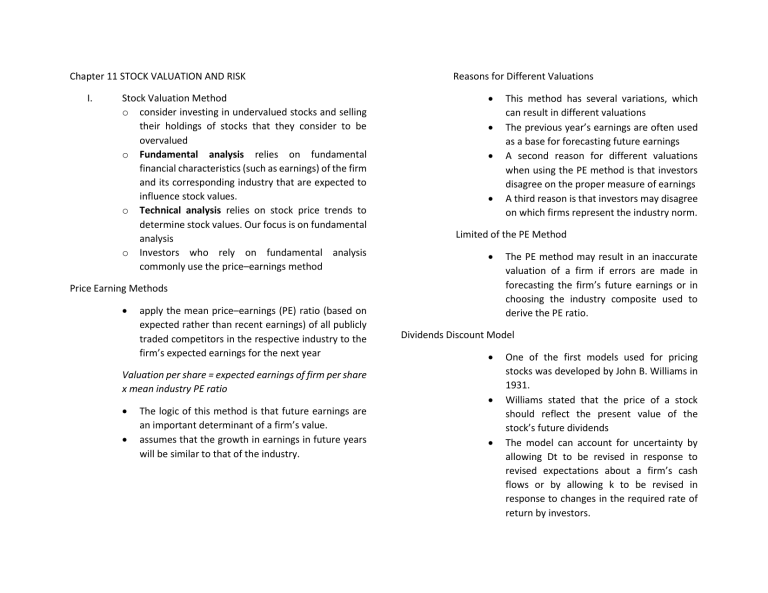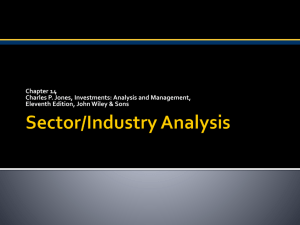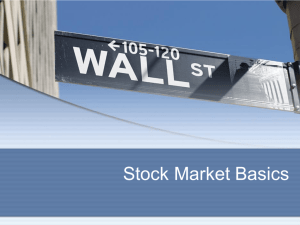
Chapter 11 STOCK VALUATION AND RISK I. Stock Valuation Method o consider investing in undervalued stocks and selling their holdings of stocks that they consider to be overvalued o Fundamental analysis relies on fundamental financial characteristics (such as earnings) of the firm and its corresponding industry that are expected to influence stock values. o Technical analysis relies on stock price trends to determine stock values. Our focus is on fundamental analysis o Investors who rely on fundamental analysis commonly use the price–earnings method Reasons for Different Valuations Limited of the PE Method Price Earning Methods apply the mean price–earnings (PE) ratio (based on expected rather than recent earnings) of all publicly traded competitors in the respective industry to the firm’s expected earnings for the next year Valuation per share = expected earnings of firm per share x mean industry PE ratio The logic of this method is that future earnings are an important determinant of a firm’s value. assumes that the growth in earnings in future years will be similar to that of the industry. This method has several variations, which can result in different valuations The previous year’s earnings are often used as a base for forecasting future earnings A second reason for different valuations when using the PE method is that investors disagree on the proper measure of earnings A third reason is that investors may disagree on which firms represent the industry norm. The PE method may result in an inaccurate valuation of a firm if errors are made in forecasting the firm’s future earnings or in choosing the industry composite used to derive the PE ratio. Dividends Discount Model One of the first models used for pricing stocks was developed by John B. Williams in 1931. Williams stated that the price of a stock should reflect the present value of the stock’s future dividends The model can account for uncertainty by allowing Dt to be revised in response to revised expectations about a firm’s cash flows or by allowing k to be revised in response to changes in the required rate of return by investors. Unfortunately, the valuation of most stocks is not this simple because their dividends are not expected to remain constant forever If the dividend is expected to grow at a constant rate, however, the stock can be valued by applying the constant-growth dividend discount model Relationship with PE Ratio for Valuing Firms the dividend discount model is highly dependent on the required rate of return and the growth rate the PE ratio is driven by the mean multiple of competitors’ stock prices relative to their earnings expectations and by the earnings expectations of the firm being valued the PE multiple is influenced by the required rate of return on stocks of competitors and the expected growth rate of competitor firms. When using the PE ratio for valuation, the investor implicitly assumes that the required rate of return and the growth rate for the firm being valued are similar to those of its competitors. When the required rate of return on competitor firms is relatively high, the PE multiple will be relatively low, results in a relatively low valuation of the firm for its level of expected earnings. When the competitors’ growth rate is relatively high, the PE multiple will be relatively high, results in a relatively high valuation of the firm for its level of expected earnings. there is a positive relationship between a firm’s growth rate and its value when applying either method. Limitations of the Dividend Discount Model The dividend discount model may result in an inaccurate valuation of a firm if errors are made in estimating the dividend to be paid over the next year or in estimating the growth rate or the required rate of return by investors Adjusted Dividend Discount Model Assess the value of any firm, from the investor’s perspective the value of the stock is equal to (1) the present value of the future dividends to be received over the investment horizon plus (2) the present value of the forecasted price at which the stock will be sold at the end of the investment horizon. Forecasted earnings in n years = E(1+G)n Investors must estimate the firm’s earnings per share in the year that they plan to sell the stock. This estimate is derived by applying an annual growth rate to the prevailing annual earnings per share. The estimate can be used to derive the expected price per share at which the stock can be sold. Stock Price in three years = earnings in three years x PE ration of industry The forecasted stock price can be used along with expected dividends and the investor’s required rate of return to value the stock today. Limitations II. Difficulty of obtaining an accurate estimate of free cash flow per period. Required Rate of Return on Stock Capital Asset Pricing Limitations of the Adjusted Dividend Discount Model If errors are made in deriving the present value of dividends over the investment horizon or the present value of the forecasted price at which the stock can be sold at the end of the investment horizon. Free Cash Flow Model For the firms that do not pay dividends – based on the present value of future cash flows. 1st step: estimate the free cash flows that will result from operations 2nd step: subtract existing liabilities to determine the value of the firm. 3rd step: divide the value of the firm by the number of shares to derive a value per share. Used to estimate the required rate of return for any firm with publicly traded stock CAPM is based on the premise that the only important risk of a firm is systemic risk. Is not concerned with so called unsystemic risk, because investors can avoid that type of risk by holding diversified portfolio. The systematic impact of general market movements on stocks in the portfolio cannot be diversified away because most of the stocks would be adversely affected by a general market decline. Rj=Rf+Bj(Rm-Rf) Given a specific Rf and Rm investors will require a higher return on a stock that has higher beta. A higher beta implies a higher covariance between the stock’s returns and market return, which reflects a greater sensitivity of the stock’s return to general market movements Estimating the Market Risk Premium Yields on newly issued Treasury bonds is commonly used as a proxy for the risk-free rate. Market risk premium - is the return of the market in excess of the risk-free rate. Estimating the Firm’s Beta A stock’s beta is typically measured by applying regression analysis to determine the sensitivity of the asset’s return to the market return based on monthly or quarterly data over the last four years or so To stock return is the dependent variable, and the market return is the independent variable over that same period. If the slope coefficient of an individual stock is estimated to be 1.2m this means that, for a given return in the market, the stock’s expected return is 1.2 times the amount. Application of CAPM III. Factors that affect stock Prices Economic Factors Firms value should reflect the present value of its future cash flows Impact of Economic Growth o Expected to increase the demand for products and services produced by firms and thereby increase a firm’s cash flows and valuation o Employment, gross domestic product, retail sales, and personal income. o Unexpected favorable information about the economy tends to cause a favorable revision of a firm’s expected cash flows and hence places upward pressure on the firm’s value. o The government’s fiscal and monetary policies affect economic growth. Impact of Interest Rates o o o o Investors should consider purchasing a risky asset only if they expect to be compensated with a risk premium for the risk incurred. High interest rate should raise the required rate of return by investors and therefore reduce the present value of future cash flows generated by a stock. Interest rates commonly rise in response to an increase in economic growth, so stock prices may rise in response to an increase in expected cash flows even if investors’ required rate of return rises. A lower interest rate should boost the present value of cash flows and boost stock prices o Lower interest rates commonly occur in response to weak economic conditions, which tends to reduce expected cash flows of firms. o The effect of interest rates should be considered along with economic growth and other factors when seeking a more complete explanation of stock price movement. Impact of the Dollar’s Exchange Rate Value o foreign investors prefer to purchase U.S. stocks when the dollar is weak and to sell them when the dollar is near its peak. Thus, foreign demand for any given U.S. stock may be higher when the dollar is expected to strengthen, o The stock prices of U.S. firms primarily involved in exporting could be favorably affected by a weak dollar and adversely affected by a strong dollar. o Stock prices of U.S. companies may also be affected by exchange rates if stock market participants measure performance by reported earnings. o A weaker dollar tends to inflate the reported earnings of a U.S. based company’s foreign subsidiaries. o The changing value of the dollar can also affect stock prices by affecting expectations of economic factors that influence the firm’s performance. o A strong dollar, however, could adversely affect this firm if it dampens U.S. economic growth o a weak dollar could indirectly affect a firm’s stock by putting upward pressure on inflation Market Related Factors Investor Sentiment - the general mood of investors in the stock market o stock valuations reflect expectations, in some periods the stock market performance is not highly correlated with existing economic conditions. Even though the economy is weak, stock prices may rise if most investors expect that the economy will improve in the near future. o there is a positive sentiment because of optimistic expectations. January Effect - This tendency places upward pressure on small stocks in January each year o Some studies have found that most of the annual stock market gains occur in January. Once investors discovered the January effect, they attempted to take more positions in stocks in the prior month o placed upward pressure on stocks in mid-December, causing the January effect to begin in December. Firm Specific Factors Change in Dividend Policy - An increase in dividends may reflect the firm’s expectation that it can more easily afford to pay dividends. Earning Surprises - Recent earnings are used to forecast future earnings and thus to forecast a firm’s future cash flows. o d earnings are higher than expected, some investors raise their estimates of the firm’s future cash flows and hence revalue its stock upward o an announcement of lower-than-expected earnings can cause investors to reduce their valuation of a firm’s future cash flows and its stock. Acquisitions and Divestitures - The expected acquisition of a firm typically results in an increased demand for the target’s stock, which raises its price. o o Investors recognize that the target’s stock price will be bid up once the acquiring firm attempts to acquire the target’s stock Divestitures tend to be regarded as a favorable signal about a firm if the divested assets are unrelated to the firm’s core business Expectations - Investors do not necessarily wait for a firm to announce a new policy before they revalue the firm’s stock o o they attempt to anticipate new policies so that they can make their move in the market before other investors. They may be able to pay a lower price for a specific stock or sell the stock at a higher price. Tax Effects The difference between the price at which a stock is sold versus the price at which it was purchased is referred to as the capital gain When investors hold a stock position less than one year, the gain is referred to as a short-term capital gain the gain on a stock position held for one year or longer is referred to as a long-term capital gain. Tax laws affect the after-tax cash flows that investors receive from selling stocks - therefore can affect the demand for stocks Holding other factors constant, stocks should be valued higher when capital gains tax rates are relatively low. Some stocks have more potential for large capital gains, and therefore may be more sensitive to the tax laws on capital gains. stocks that pay steady dividends typically have smaller capital gains and therefore may not be affected as much by tax laws on capital gain stocks that pay dividends are affected by dividend tax laws low tax rate imposed on dividends will cause dividend-paying stocks to be more desirable, and will increase the valuation of these stocks. A high tax rate imposed on dividends will cause these stocks to be less desirable Integration of Factors Affecting Stock Prices IV. Stock Risk A stock’s risk reflects the uncertainty about future returns The main source of uncertainty is the price at which the stock will be sold. Dividends tend to be much more stable than stock prices Dividends contribute to the immediate return received by investors but reduce the amount of earnings reinvested by the firm, which limits its potential growth. The risk of a stock can be measured by using its price volatility, its beta, and the value-at-risk method. Volatility of Stock Indicators of inflation (such as the consumer price index and producer price index) and of government borrowing (such as the budget deficit and the volume of funds borrowed at upcoming Treasury bond auctions) also affect the risk-free rate and thereby the required return of investors. whenever these indicators signal the expectation of higher interest rates, there is upward pressure on the required rate of return by investors and downward pressure on a firm’s value it is common to estimate expected future cash flows when deriving a firm’s value, and these cash flows are influenced by economic conditions, industry conditions, and firmspecific conditions A stock’s volatility serves as a measure of risk because it may indicate the degree of uncertainty surrounding the stock’s future returns. The volatility is often referred to as total risk because it reflects movements in stock prices for any reason, not just movements attributable to stock market movements Using Standard Deviations to Forecast Stock Price Volatility. o The volatility is often referred to as total risk because it reflects movements in stock prices for any reason, not just movements attributable to stock market movements Using Volatility Patterns to Forecast Stock Price Volatility o A second method for forecasting stock price volatility is to use volatility patterns in previous periods. o Normally the weights and the number of previous periods (lags) that were most accurate (i.e., had the lowest forecast error) in previous periods are used Using Implied Volatility to Forecast Stock Price Volatility o implied standard deviation (ISD) o The premium on a call option for a stock depends on various factors, including the stock’s volatility as anticipated by investors. o By considering the actual option premium paid by investors for a specific stock along with the values of all other factors that affect the premium, it is possible to derive the anticipated volatility of that stock. Forecasting Stock Price Volatility of the Stock Market o Market participants who want to forecast volatility of the stock market in general can monitor the volatility index (VIX) derived from stock options on the S&P 500 stock index. At a given point in time, this index measures investors’ expectation of the stock market volatility over the next 30 days o If conditions occur that cause investors to expect more uncertainty surrounding stock prices over the next 30 days, this means that investors would require a higher premium in order to sell call options o if conditions in the stock market are expected to be more stable over the next 30 days, the premium on call options would decline and the VIX index would decline. While it would be impossible to survey all market participants to obtain their view of stock market volatility o When there is a sharp rise in VIX, stock prices tend to decline, as the conditions that cause more stock market fear also cause investors to sell their stocks, which results in lower stock prices. Conversely, when there is a sharp decline in VIX, stock prices tend to rise, as the conditions that make investors believe that stock prices will be more stable also encourage investors to purchase stocks, which results in higher stock prices. Volatility of Stock Portfolio o Participants in the stock market tend to invest in a portfolio of stocks rather than a single stock o A portfolio’s volatility depends on the volatility of the individual stocks in the portfolio, on the correlations between returns of the stocks in the portfolio, and on the proportion of total funds invested in each stock. o The equation for a two-stock portfolio is sufficient to demonstrate that, when other factors are held constant, a stock portfolio has more volatility when its individual stock volatilities are high and when its individual stock returns are highly correlated o if the returns of the stocks are all perfectly positively correlated (correlation coefficients ¼ 1.0), the portfolio will have a relatively high degree of volatility because all stocks will experience peaks or troughs simultaneously o a stock portfolio containing some stocks with low or negative correlation will have less volatility because the stocks will not experience peaks and troughs at the same time o Beta of a Stock This measure of risk is used by many investors who have a diversified portfolio of stocks and believe that the unsystematic risk of the portfolio is therefore diversified away Beta of a Stock Portfolio o Portfolio risk is commonly measured by beta or volatility (standard deviation) o the portfolio beta is a weighted average of the betas of stocks that make up the portfolio o where the weights reflect the proportion of funds invested in each stock o simply suggests that a portfolio consisting of highbeta stocks will have a relatively high beta. o performs poorly relative to other stock portfolios in a period when the market return is negative. o High-beta stocks are expected to be relatively volatile because they are more sensitive to market returns over time. o low-beta stocks are expected to be less volatile because they are less responsive to market returns. Value at Risk o a measurement that estimates the largest expected loss to a particular investment position for a specified confidence level o If the investors are uncomfortable with the potential loss that could occur in a day or a week, they can revise their investment portfolio to make it less risky. o focuses on the pessimistic portion of the probability distribution of returns from the investment of concern The higher the level of confidence desired, the larger the maximum expected loss that could occur Application Using Historical Return o An obvious way of using value at risk is to assess historical data Application Using the Standard Deviation o An alternative approach is to measure the standard deviation of daily returns over the previous period and then apply it to derive boundaries for a specific confidence level. Application Using Beta o A third method of estimating the maximum expected loss for a given confidence level is to apply the stock’s beta. o The maximum expected market loss for the 95 percent confidence level can be derived subjectively or by assessing the last 100 days or so (in the same manner described for the two previous methods that can be used to derive the maximum expected loss for an individual stock). Deriving the Maximum Dollar Loss Application to a Stock Portfolio o o Value at risk is also commonly used to measure the risk of a stock portfolio. Alternatively, the standard deviation of the portfolio’s returns can be estimated over the past 100 days to derive a lower boundary at a specified confidence level. Adjusting the Investment Horizon Desired o it is important in this case to use a historical series that matches the investment horizon o to assess the maximum loss over a given week in the near future, a historical series of weekly returns of that stock (or stock portfolio) can be used. Adjusting the Length of the Historical Period o a sub period of weak market performance should not be discarded because a similar one could occur again. Limitations of the Value-at-Risk Method o t portfolio managers may be using a relatively calm historical period when assessing possible future risk o the distribution of possible returns used to estimate value at risk may have short tails (edge of the distribution) whereas the distribution of returns over the future period may have long tails. This implies that the actual loss of a portfolio may be more pronounced than the expected maximum loss V. Risk-Adjusted Stock Performance o The performance of a stock or a stock portfolio over a particular period can be measured by its excess return (return above the risk-free rate) for that period divided by its risk Sharp Index o If total variability is thought to be the appropriate measure of risk, a stock’s risk-adjusted returns can be determined by the reward-to-variability ratio (also called the Sharpe index): o The higher the stock’s mean returns relative to the mean risk-free rate and the lower the standard deviation, the higher the Sharpe index. o VI. The Treynor index differs from the Sharpe index only in that it uses beta rather than the standard deviation to measure the stock’s risk. The higher the Treynor index, the higher the return (per unit of risk) relative to the risk-free rate. Stock Market Efficiency o the prices of stocks at any point in time should fully reflect all available information. o This does not mean that markets are inefficient unless the reaction is biased Forms of Efficiency Weak-Form Efficiency o suggests that security prices reflect all marketrelated information, o Thus, investors will not be able to earn abnormal returns on a trading strategy that is based solely on past price movements. Semi strong-Form Efficiency o suggests that security prices fully reflect all public information o public information also includes announcements by firms, economic news or events, and political news or events o Market-related information is a subset of public information o if semi strong-form efficiency holds, weak-form efficiency must also hold Strong-Form Efficiency o suggests that security prices fully reflect all information, including private or insider information o If strong-form efficiency holds, semi strong-form efficiency must hold as well. Test of the Efficient Market Hypothesis Test of Weak-Form Efficiency o tested by searching for a nonrandom pattern in security prices o If the future change in price is related to recent changes, historical price movements could be used to earn abnormal returns o studies have found that historical price changes are independent over time. o historical information is already reflected by today’s price and cannot be used to earn abnormal profits Test of Semi Strong-Form Efficiency o been tested by assessing how security returns adjust to particular announcements o the return over the first day following the IPO tends to be abnormally high. o the securities firms underwriting an IPO intentionally underprice to ensure that the entire issue can be placed. o investors would not participate unless prices are low - the potential return must be high enough to compensate not only for the risk incurred but also for the lack of information about these corporations. Test of Strong-Form Efficiency o Tests of strong-form efficiency are difficult because the inside information used is not publicly available and cannot be properly tested.





